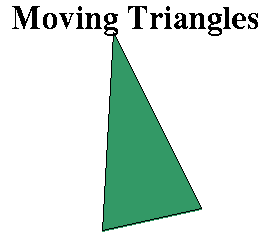| Some Maple animations |
Maple's plots package has an animation
feature. For example, try
with(plots): animate(sin(x*t), x=-Pi..Pi, t=-5..5);
Click on the plot to select it, and then choose the Play option on the Animation controls to see the movie. (There is an Animation menu on the main menu bar; also you can enable the Context Bar on the View menu, and then pictorial controls will appear in the context bar when you select the animated plot.)
It is also possible to create a movie "by hand" by splicing together a sequence of plots. For example, the following code mimics a screen saver that bounces a geometric figure around the screen.
Warning. Before you try this example, save your work and
close any unneeded windows. Since this example uses a lot of
colors and demands a lot of Maple's memory, it could possibly
crash your Maple session. (If that happens, try again with the
number of iterations set to i=1..10 instead of
i=1..100.)
r1:=rand(-10..10): r2:=0.2*rand(6):
p:=seq(plots[polygonplot]([[r1(),r1()],[r1(),r1()],[r1(),r1()]],
color=COLOR(RGB, r2(), r2(), r2() ) ), i=1..100):
plots[display]([p], insequence=true, axes=none,
title="Moving Triangles", titlefont=[TIMES,BOLD,72]);
 If you cut and
paste this code into a Maple session and execute it, you
should get a plot that looks something like
the figure.
When you
start the animation playing, you should see randomly colored
triangles move around the window.
If you cut and
paste this code into a Maple session and execute it, you
should get a plot that looks something like
the figure.
When you
start the animation playing, you should see randomly colored
triangles move around the window.
Explanation: Maple's rand command is a pseudo-random
number generator. The command rand(-10..10) defines a
procedure to generate a random integer between -10 and
10, so the polygonplot command above makes a triangle
whose vertices are at random integral points within a 20 by
20 square. The command rand(6) defines a procedure to
generate a random integer between 0 and 5 inclusive, so
the color instruction above generates a color with a random
mixture of Red, Green, and Blue in the standard
216-node color cube. The whole
procedure generates a sequence of 100 randomly placed
triangles with random colors, and the insequence=true
command produces the animation.
Exercise
Reproduce the Math 696 logo by using a Maple animation.
 The Math 696 course
pages were last modified April 5, 2005.
The Math 696 course
pages were last modified April 5, 2005.| Some Maple animations |